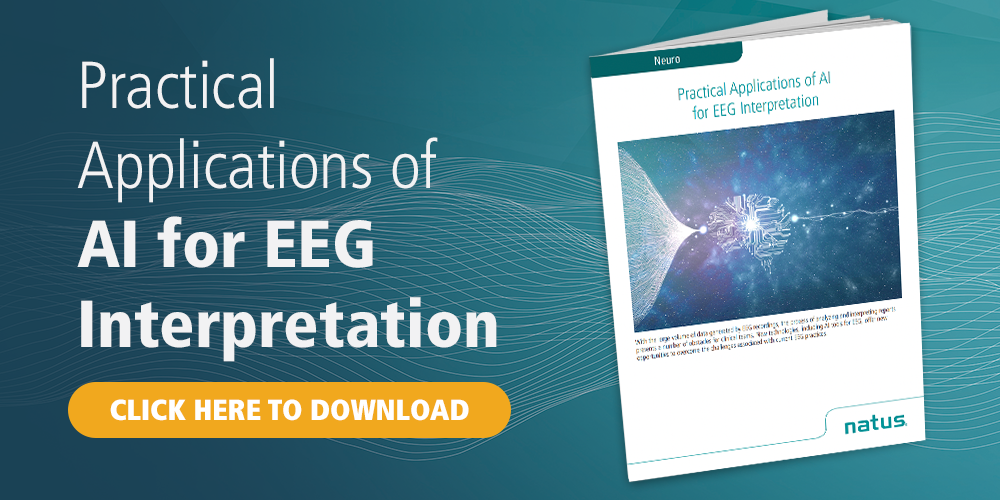
In the rapidly evolving landscape of healthcare IT, AI has emerged as a pivotal force to help health professionals become more efficient and effective. The adoption of AI in the medical field has varied by specialty and application, with some areas moving faster than others. For many years, cardiology, for example, has used AI for ECG and imaging tests to detect subtle cardiac abnormalities more easily and to deliver timelier evaluations. The same is true in radiology and mammography, where the use of AI technology has surged in the last decade.1
The applications of AI for neurology are many, from enabling autonomous robotic surgery and predicting epilepsy surgery outcomes, to autoclassification of images for neuro-oncologists.² Yet within the rapidly advancing field of neuro AI, some of the greatest benefit is from the use of AI for EEG interpretation. As these tools evolve from more traditional machine learning algorithms to technology that incorporates deep learning, neurologists, epileptologists, neurodiagnostic personnel, and other health professionals are seeing a remarkable boost to efficiency that is driving down cost while improving health outcomes.
EEG recordings generate large amounts of data so it’s not surprising that for the past four decades machine learning has been used in some form of EEG classification³ By quickly identifying potential anomalies, traditional algorithms have long helped neurologists and neuro care teams prioritize critical cases, enabling more timely interventions for patients with serious neurological disorders.
It’s extremely helpful that large numbers of validated EEG records already exist, providing AI tools with ample information to learn from. Today’s advanced algorithms are trained on enormous, validated datasets, training the tools to recognize subtle abnormalities in EEG waveforms that might elude human observation. Neuro AI is particularly valuable in long-term monitoring scenarios, where identifying trends or changes over time is essential.4 By automatically flagging deviations from baseline patterns, algorithms ensure that neurologists can promptly address even rapidly evolving neurological conditions. In addition, deep learning algorithms and neural networks trained correctly on large, properly noted datasets have the potential to significantly reduce the time neuro care teams spend on EEG interpretation and analysis.
Specifically, neuro AI tools for EEG are expected to reduce time and increase efficiencies in several areas of note, including:
Collaborative Human-AI Interaction
The Brookings Institute defines the concept of human-machine teaming as a relationship consisting of three elements, the human, the machine, and the interactions and interdependencies between them. For highly complex tasks such as EEG analysis, AI has the potential greatly enhance outcomes when used to augment and support human capabilities. Once trust is built between neuro care teams and AI technology, this partnership results in a synergistic approach that moves far beyond what either could achieve independently.9
Human-machine teaming also requires a strong focus on continuous feedback loops. AI continues to learn as it receives new data, while human feedback helps refine and speed up algorithm performance. This results in an improved ability to detect nuanced patterns and real-time events, decreased time spent on more repetitive EEG interpretation tasks, and increased accuracy rates. Where expertise is scarce, AI tools can significantly reduce the time to diagnosis, improving access to neuro care for remote and underserved communities.
The integration of AI with EEG analysis expedites processes that traditionally could take many hours, significantly boosting the efficiency of neuro care teams. Looking ahead, AI tools for neurology hold immense promise. Advancements in deep learning and pattern recognition will continue to refine event detection and help identify even subtler abnormalities in increasingly shorter timeframes. As AI continues to evolve, human-machine teaming will shape the future of EEG interpretation and analysis, creating a more precise, efficient, and patient-centered approach to neurological healthcare.
SOURCES
1. Dobkin PL. Art of medicine, art as medicine, and art for medical education. Can Med Educ J. 2020 Dec 7;11(6):e172-e175. doi: 10.36834/cmej.70298. PMID: 33349773; PMCID: PMC7749674.
2. Ganapathy Krishnan, Abdul Shabbir Syed, Nursetyo Aldilas Achmad “Artificial intelligence in neurosciences: A clinician’s perspective” Neurology India 2018, Volume 66, Issue Number 4, Page 934-939
3. Saeidi M, Karwowski W, Farahani FV, Fiok K, Taiar R, Hancock PA, Al-Juaid A. Neural Decoding of EEG Signals with Machine Learning: A Systematic Review. Brain Sci. 2021 Nov 18;11(11):1525. doi: 10.3390/brainsci11111525. PMID: 34827524; PMCID: PMC8615531.
4. Varatharajah Y, Berry B, Cimbalnik J, Kremen V, Van Gompel J, Stead M, Brinkmann B, Iyer R, Worrell G. Integrating artificial intelligence with real-time intracranial EEG monitoring to automate interictal identification of seizure onset zones in focal epilepsy. Neural Eng. 2018 Aug;15(4):046035. doi: 10.1088/1741-2552/aac960. Epub 2018 Jun 1. PMID: 29855436; PMCID: PMC6108188.
5. Deep learning-based electroencephalography analysis: a systematic review. Yannick Roy5,1, Hubert Banville5,2,3, Isabela Albuquerque4, Alexandre Gramfort2, Tiago H Falk4 and Jocelyn Faubert1. Published 14 August 2019 • © 2019 IOP Publishing Ltd. Journal of Neural Engineering, Volume 16, Number 5Citation Yannick Roy et al 2019 J. Neural Eng. 16 051001DOI 10.1088/1741-2552/ab260c
6. He C, Liu J, Zhu Y, Du W. Data Augmentation for Deep Neural Networks Model in EEG Classification Task: A Review. Front Hum Neurosci. 2021 Dec 17;15:765525. doi: 10.3389/fnhum.2021.765525. PMID: 34975434; PMCID: PMC8718399.
7. Djanian S, Bruun A, Nielsen TD. Sleep classification using Consumer Sleep Technologies and AI: A review of the current landscape. Sleep Med. 2022 Dec;100:390-403. doi: 10.1016/j.sleep.2022.09.004. Epub 2022 Sep 22. PMID: 36206600.
8. Kent Jessica, HealthITAnalytics. (2020, June 30). Artificial intelligence detects epileptic seizures in real time. https://healthitanalytics.com/news/artificial-intelligence-detects-epileptic-seizures-in-real-time
9.Resnick, D., & Wessel, D. (2021, February 18). Building Trust in human-machine teams. Brookings. https://www.brookings.edu/articles/building-trust-in-human-machine-teams/
Related Articles
